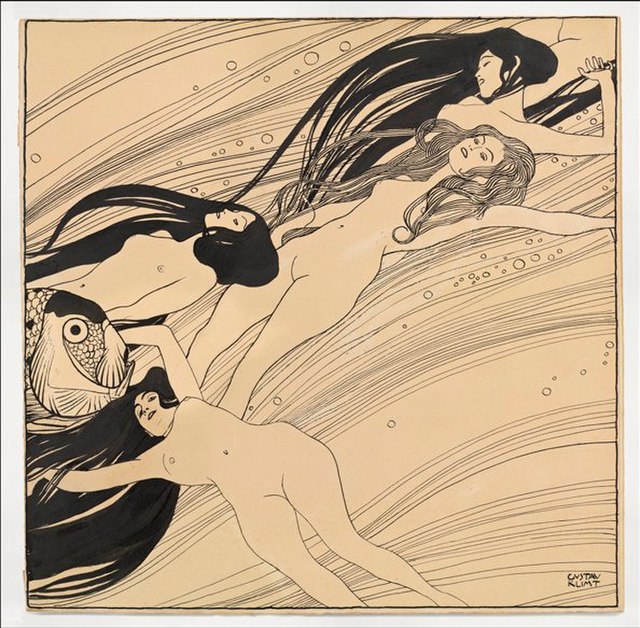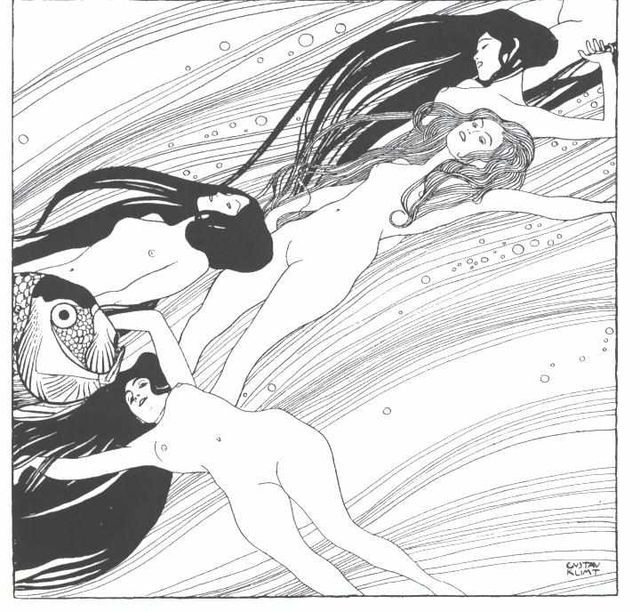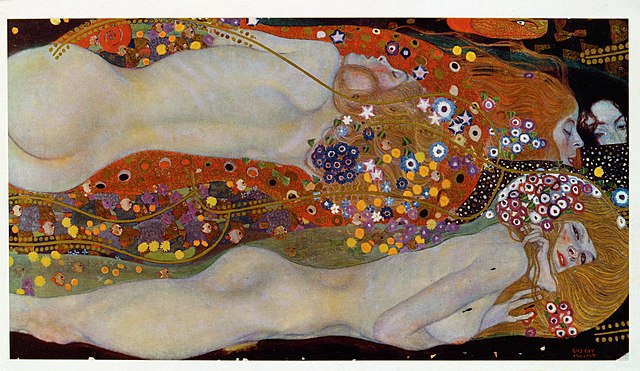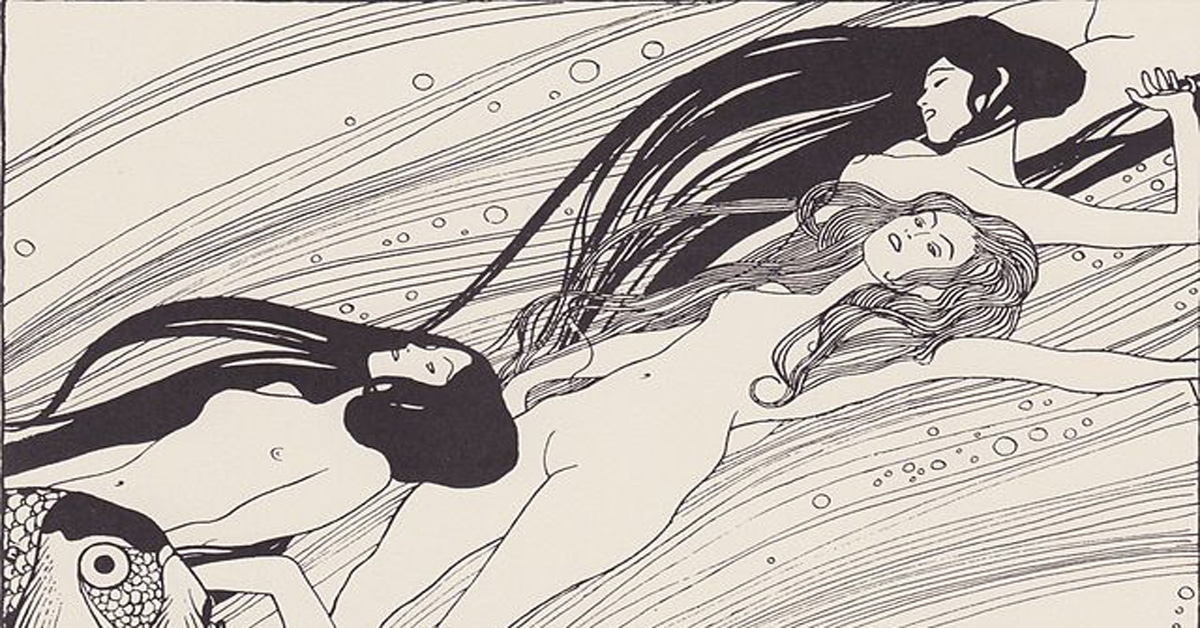Known as one of Austria’s most famous painters, and renowned as an important founder of
the Vienna Secession in 1897, Gustav Klimt remains a significant figure in art history. Pieces
including The Kiss (1908 – 09) and Adele Bloch-Bauer I (1907) are often celebrated as his
best, and Klimt continues to be admired and revered throughout the art world.
Having trained at the Vienna School of Arts and Crafts (the Kunstgewerbeschule), where he
learned from the study of Old Masters such as Rubens and Velázquez, Klimt was
accomplished as a painter and drawer, and his murals, sketches, and paintings continue to
be celebrated. Although Klimt is arguably best known for his ‘Golden Phase’, when he began
to integrate gold leaf into his pieces, other artworks like Fish Blood (Blood of Fish) are
nonetheless important for what they reveal about Klimt’s changing practice, and his
departure from more conventional Realist aesthetics and techniques.
Historical Background to Fischblut (Blood of Fish)
Klimt continues to be recognised for his radical focus on the sensuality and eroticism of the
female body. However, at the time of his work, the degree to which Klimt took inspiration
from the female body led to criticism.
In 1894, Klimt had been commissioned to produce three ceiling paintings for the Great Hall
of the University of Vienna. Upon their creation, these paintings – Philosophy, Medicine, and
Jurisprudence – were criticised for what was seen as their pornographic aesthetics. Klimt
was so enraged by this response and refusal of his art that it prompted him to swear off
public commissions forever. The paintings he created were never hung at the University,
and were in fact eventually destroyed at the end of World War II.
Around the same time, Klimt gave up his membership to Vienna’s premiere society of artists
(the Association of Austria Artists, or Kunstlerhaus) alongside a number of other
contemporary artists and designers. Klimt and his contemporaries were frustrated by what
they saw as the priority given to more conservative, traditional artistic styles when it came
to exhibition space. Along with others including architects Josef Hoffman and Otto Wagner,
and designer Koloman Moser, Klimt co-founded The Vienna Secession on 3 April 1897.
Although they refused an official manifesto, the group was designed to provide a space for
more radical young artists to exchange ideas and exhibit their pieces.
Whilst the Secession did eventually fracture and fall apart as a result of in-group fighting
and disagreement, with Klimt and others leaving in 1905, it was nonetheless a revolutionary
and reformative art movement that had been created in order to challenge pre-existing
academic traditions. It was during his time in the Secession that Klimt arguably created
some of his most famous pieces – including Fischblut (Blood of Fish).

Fischblut (Blood of Fish)
During the early years of the Secession, Klimt began to develop and play around with a
different style of space and representation, inspired by both Japanese wood block art and
the aesthetics of Greek vase painting. Both of these influences can be seen in the piece Fish
Blood.
Fish Blood (Fischblut in Klimt’s native Austrian) was explicitly crafted for publication in the
Secessionists’ periodical Ver Sacrum (‘Sacred Spring’). It has been identified as Klimt’s most
important graphic work, and shows four naked female figures drawn from a combination of
brushwork and black ink, black chalk, and white highlights. The outline of the female bodies
is distinguished by way of firm, stark outlines, but whilst the piece departs from Realist
dimensionality, it nonetheless is a lively artwork with dimensionality created by its curves
and drawn detail.
Three of the four women’s bodies appear to drift towards the top right of the artwork, and
are accompanied by sweeping lines that reflect the women’s hair and, perhaps, seaweed, as
well as a number of aquatic bubbles. The most striking figure in Blood of Fish is the fish
head, which faces upwards, like the women’s bodies, and has been said to demonstrate the
connection of the human world of the women with the natural.

Fischblut (Blood of Fish) – style and aesthetics
Fish Blood (Blood of Fish) marked a stylistic departure for Klimt from a more classical,
conventional Realist aesthetic and artistic practice to a Modernist approach. The Art
Nouveau style that Fish Blood hints at continued throughout Klimt’s oeuvre, where he
continued to change his use of shape, figuration, symbol, and space, departing from the
three-dimensionality of Realism and embracing a cleaner, more contemporary approach to
the figure of the body.
The piece demonstrates Klimt’s focus on the female body, which would continue
throughout his work, eventually becoming a characteristic for which Klimt continues to be
famous.
The general aesthetic of Fish Blood (Blood of Fish) is luscious, and there’s an embrace of
pleasure, sensuality, and sexual freedom in the piece. The women’s free-flowing hair mimics
that of the clean, curved lines behind them, as they allow their bodies to recline and flow
freely in the water’s motion with a kind of ecstatic abandon.
It was this embrace of sensuality and pleasure – in particular female pleasure – that
characterised Klimt’s work moving forward. He continued to recoil from conservative
attitudes towards sexuality in a way that was genuinely radical at the time of his practice.
The focus on more radical themes and styles demonstrated by Fish Blood continued
throughout Klimt’s artistic practice, and, in fact, arguably had precedent in the ceiling
paintings that the University of Vienna commissioned from him and eventually rejected. The
painting Medicine, in particular, showed a floating female figure to the upper left of the oil
sketch, which is not dissimilar (though created in a more Realist style) to the floating female
figures of Fish Blood (Blood of Fish).
Interpretations of Fischblut (Blood of Fish)
The floating female bodies of Fish Blood occupy an undesignated time and space, and are
untethered in either, reflecting Klimt’s growing interest in the relationship between
humanity and nature, where humanity has no control over their fate in a wider universe.
This is conveyed by the incomplete figures in the piece – all of the women have their feet or
hands cut off, for example, and the top right figure is almost completely disjointed and
disembodied. Critics have argued that this further represents the metaphysics of an endless
life, as embodied by both the fish and female figures.
Fischblut (Blood of Fish) and other Klimt artworks
Fish Blood (Blood of Fish) can be seen as heralding future Klimt artworks, including Goldfish
(1901 – 02), Moving Water (1898), Nymphs (Silver Fish) (1899) and Water Serpents I (1904)
and Water Serpents II (1904 – 07). In each of these artworks, female bodies are displayed in
sensual, evocative positions, and possess a curving grace and ethereal embrace of their
pleasure and eroticism.
Goldfish developed the same Symbolism and Art Nouveau elements of Fish Blood, and
shows a similar use of the naked female body alongside aquatic figures and images,
including that of a goldfish head, much like in Fish Blood (Blood of Fish). Moving Water is
very similar to Fish Blood, in that it shows naked female figures enveloped by loose-flowing
hair, drifting through water. It has been suggested that Fish Blood was the inspiration for
Moving Water.
By virtue of the fact that Goldfish was initially named ‘To my critics’, it is clear that this piece
was created by Klimt in direct refusal of the very conservative attitudes that had resulted in
the refusal of his paintings by the University of Vienna. Klimt only changed the name of the
piece to Goldfish when he came to display it during a 1903 Secession exhibition, but the
press was nonetheless furious with the artwork for its explicitly erotic provocations.

